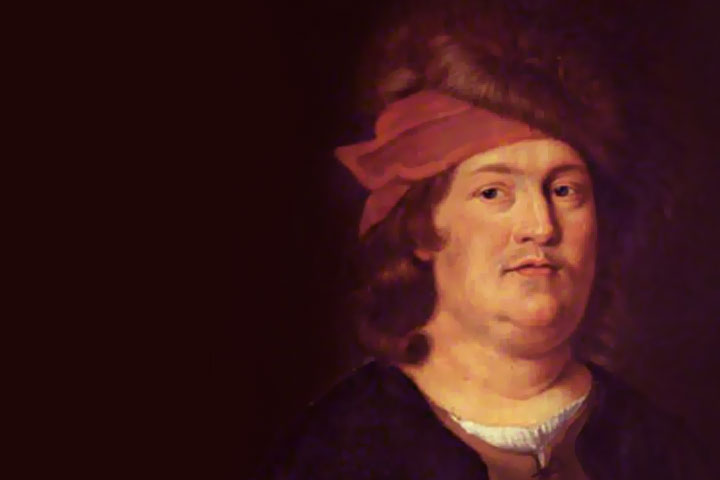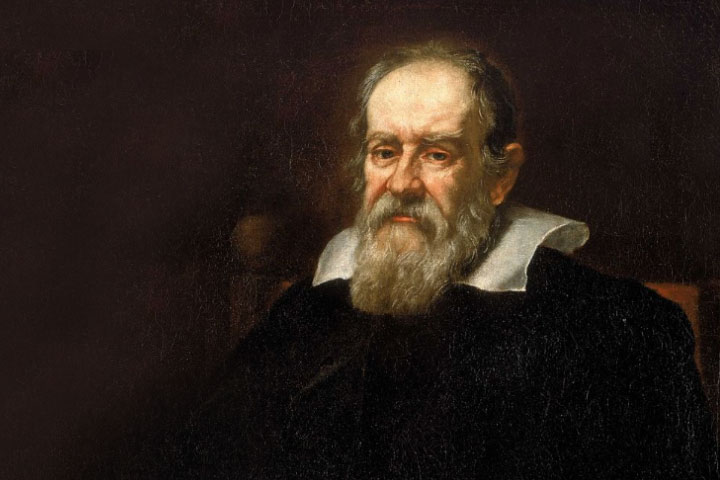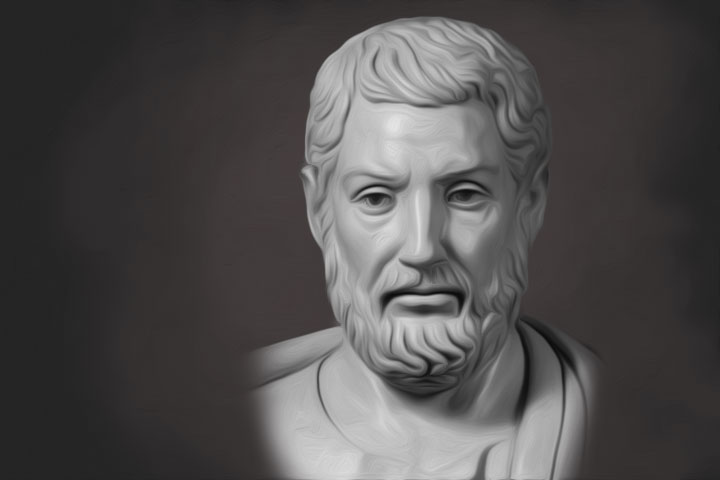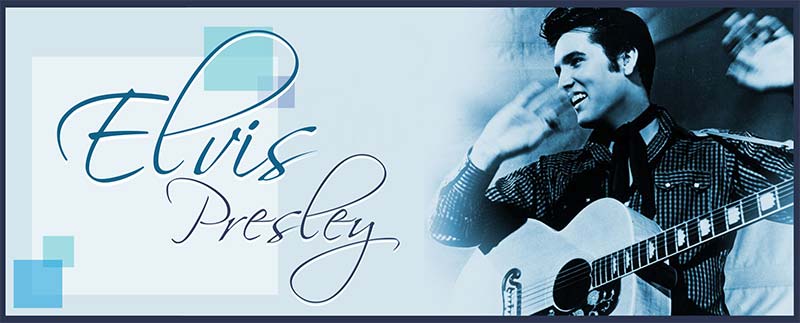

Introduction
Let’s blend the music of the African-Americans, their gospel songs, rhythm and blues with a little of pop and country music of the Americans. So what do you get? Famous rock ‘n’ roll songs like ‘Hound Dog’, ‘Jailhouse Rock’, ‘Mystery Train’, ‘Suspicious Minds’ etc.? Correct. The man who created and popularised rock ‘n’ roll music was a talented white man, an American singer and entertainer with his roots in Southern music – Elvis Presley. Well, maybe his celebrated songs, ‘Can’t Help Falling in Love’, and ‘A little less Conversation’ ring a bell in your ears?
Commonly known by his first name Elvis, he was gifted with a high baritone and a broad vocal range. Elvis entertained people with his repertoire of rockabilly, rock ‘n’ roll, pop, rhythm and blues (R&B) music, gospel ballads and even releasing chart bursting albums. His multiple talents and powerful voice set him apart as the ‘King of rock ‘n’ roll music, a harbinger of a radical music style, which earned him widespread international recognition. He had an incredible stage presence and an inimitable dancing style bordering on the erotic and winning him teenage fans worldwide. Memoirs on rock history list him as leaving his audiences hysterical. This great entertainer gave over 1100 live performances all through his ‘concert years’ from 1969 to 1977.
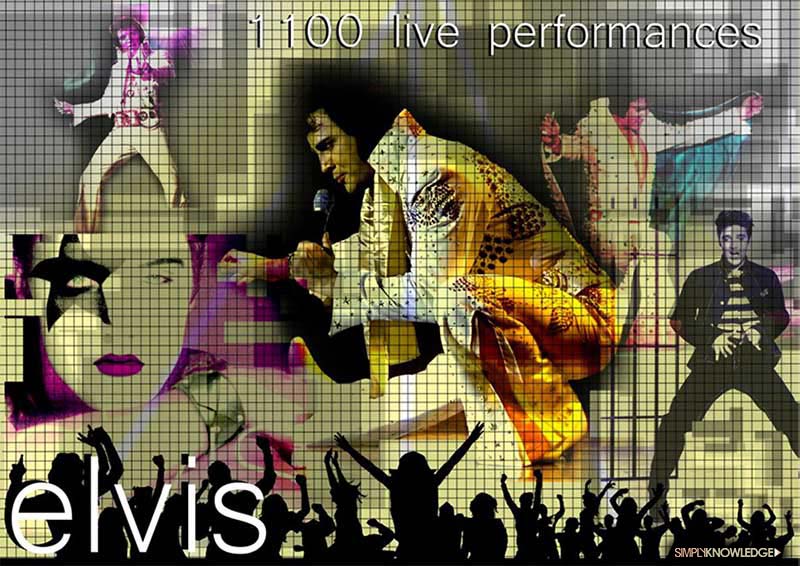
Elvis had drop-dead good looks and was extremely charming. He is also known for starring in a series of very successful Hollywood musical comedy movies, like ‘Blue Hawaii’, ‘King Creole’, ‘GI Blues’ and ‘Viva Las Vegas’, that showcased his acting talents. Moreover, many of his hit songs were included as Hollywood movie soundtracks.
Even though global telecommunication during his time was at a nascent stage, Elvis Presley made international television history with a worldwide live broadcast of his television special ‘Elvis - Aloha from Hawaii’, via satellite. Come, let us journey through the life and times of this heartthrob of millions, whose music has left a revolutionary imprint on our minds.
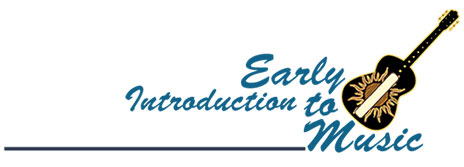
early introduction to music
During the great economic depression, in the wee hours of one winter morning on 8th January, 1935, two boys were born to Gladys Presley, the wife of Vernon Presley in Tupelo town, Mississippi. One child was stillborn and the other grew up as Elvis Aaron Presley. Vernon worked as a carpenter, a farmer, and at times a factory worker, to provide the much needed relief to his poverty ridden family. The charity of friends and neighbours gave little Elvis his diapers as his parents were dependent on welfare.
The Presleys brought up their only son Elvis with lots of love, affection and taught him good behaviour. They were religiously inclined - a trait that was intensely visible in Elvis all through his life. Elvis had his first taste of music at the Assembly of God Church at the tender age of two. Rather than sit quietly in his mother’s lap, little Elvis would frolic around and try to sing with the choir where his parents sang. It is not surprising that this first taste of gospel singing by preachers and worshippers left an everlasting impact on Elvis, to become a part of his life forever.
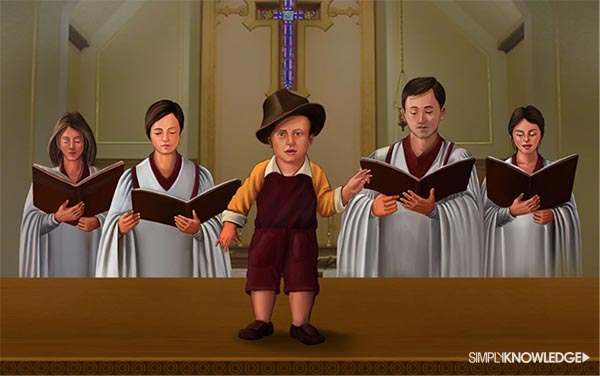

A Family in Distress
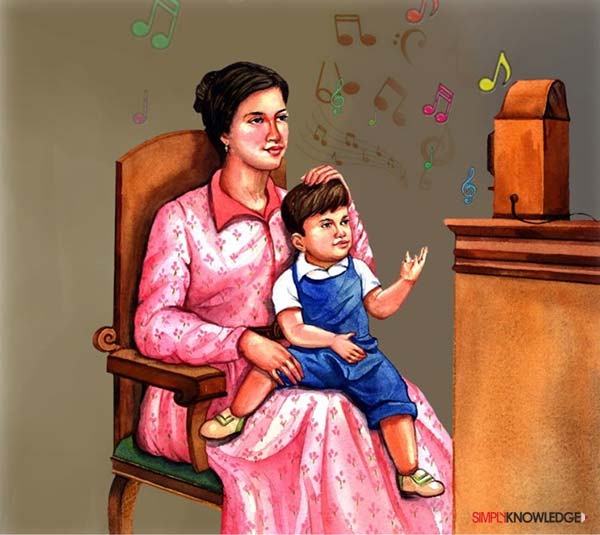
When Elvis was three years old, his father Vernon was suddenly sent to prison, for forging a cheque. This resulted in Elvis bonding more emotionally to his mother Gladys. Gladys struggled to provide for them by ironing clothes but at times her meagre income failed to come through. Elvis would visit his father in prison every week along with his mother.
Gladys’s protective nature ensured that she never left Elvis out of her sight, which limited his interaction with others. So, Elvis spent his time reading comics or listening to music. He had a good memory and an ear for tunes and rhythms. His mother groomed him to be a polite, well-mannered son. Gladys also instilled in him the thought that he was an extremely ‘special boy’ because of which Elvis became reserved, an attitude that remained with him forever.

Little Elvis’ Singing Talents Exposed
At the age of 6, Elvis joined the Lawhon Elementary school in 1941, where he began singing gospel. He also sang at the local church choir. Ironically, Oleta Grimes, the daughter of Orville S Bean - the man who had sent his father to prison previously, was Elvis’ fifth grade elementary school teacher. She discovered his singing talents during morning prayers and gave Elvis the confidence to sing in public by deeply appreciating him. Then finally, on 3rd October, 1945, a 10 year oldElvis gave his earliest public show at a radio contest held at the annual Mississippi-Alabama Fair and Dairy Show in the city centre of Tupelo. Little Elvis had worn glasses and was clad like a cowboy. He stood on a chair and sung ‘Old Shep’ on the microphone, without any accompanying instruments. His curled upper lip, for which he became famous later, was visible even then. This first singing act of Elvis was broadcast over WELO radio. He won the fifth prize with $5, plus free ride passes. This set him on the path that brought him immense wealth and made him a celebrity in his later years.
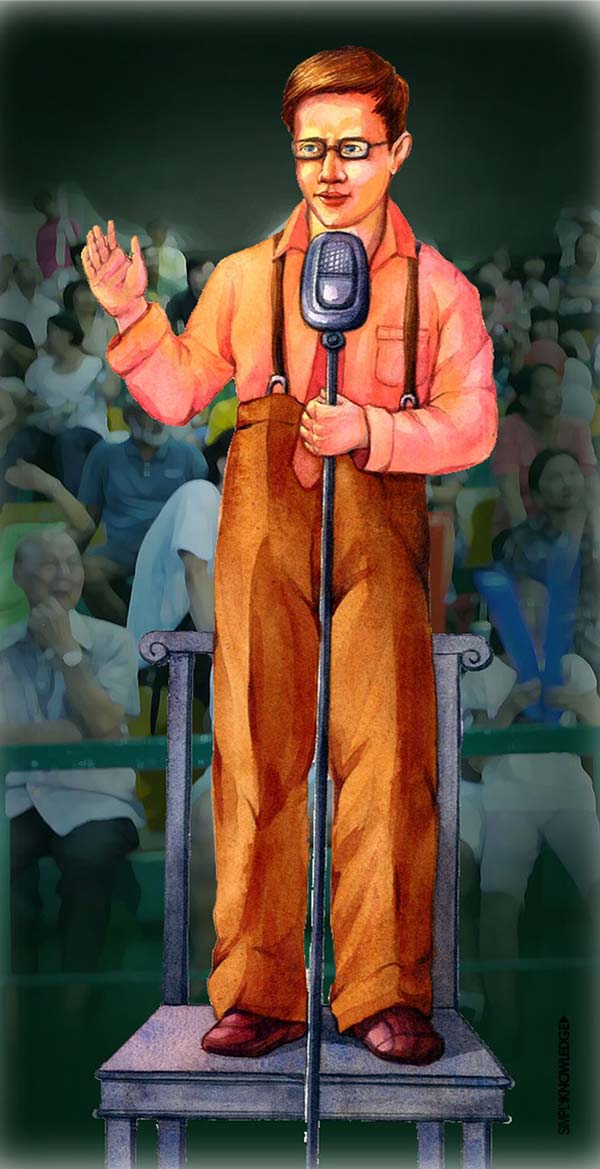
Gladys presented little Elvis a guitar on his eleventh birthday. Uncle Vester, his father’s brother then introduced Elvis to the different chords. The preacher at their family church too gave Elvis guitar lessons after which Elvis began playing and singing at the church. Yet, his singing remained confined to known people, as he was scared of singing to an unknown crowd. Much later recollecting this early phase, Elvis Presley said, “I took the guitar, and I watched people, and I learned to play a little bit. But I would never sing in public. I was very shy about it.”
Financially distressed, the Presley family was forced to relocate several times which forced Elvis to change schools and live in coloured neighbourhoods, subsisting on the paltry earnings by his parents. Meanwhile, the unrestrained mind of Elvis absorbed the cultural influences in his immediate ‘coloured’ vicinity where the local African-American community resided. What left an impression on Elvis was their popular Southern musical style, called ‘race music’. Race music was an evolving blend of the urban rhythm and blues (R&B), bluegrass, spiritual gospel and country, which the Afro-American musicians usually sung and performed with hip-swinging and swaying movements. Elvis was easily drawn to this typical Southern culture in his neighbourhood.
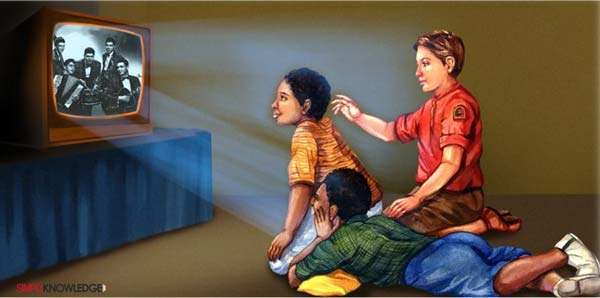
Now in the sixth grade at Milam Junior High School, Elvis was like any regular student. Though impeccably well-behaved, he was an extremely shy 11-year old kid. But by his seventh grade, Elvis was noticed playing his guitar at lunch hours, where he adorned his music with a touch of ‘race music’. However, it disgusted his white classmates, who could not relate with African-American music. To them, Elvis was often the subject of ridicule as they responded by cutting off his guitar strings.
Elvis often visited the Tupelo radio stationWELO, where the celebrity Mississippi Slim, as Carvel Lee Ausborn was known, hostedhis midday show. At age 12, Elvis was a big fan of Slim, whose younger brother James, studied with him. James apprised his brother of Elvis' craze for music. Under Slim, Elvis learnt more chord techniques as well as songs. Slim then gave Elvis a chance for two performances at the fashionable radio program –WELO Saturday Jamboree, which initiated him into the singing industry. In the first attempt, Elvis was taken by stage fright, but he finally performed the next week.
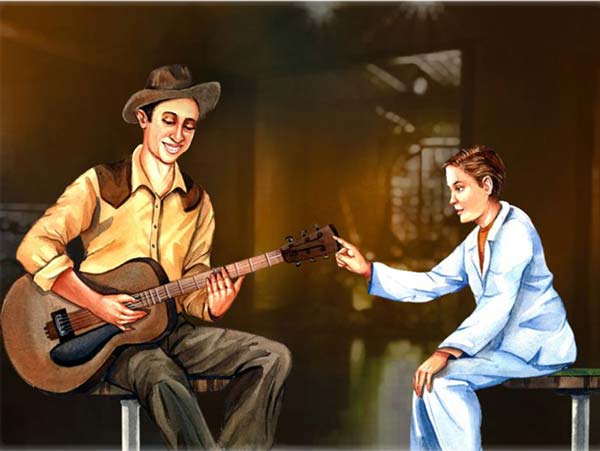

Life in Memphis - The Heart Of Race Music
When Elvis was 13 years old, the Presley family sold their furniture and moved to Memphis, Tennessee with their meagre possessions. This lively and happening city was home to a variety of music such as blues, country, bluegrass, and gospel that wrapped up little Elvis’ mind. Elvis was admitted in L. C. Humes High School, a school for the white community. As he was too reticent, Elvis was seen by his new classmates in the eighth grade as ‘mama’s boy’. He was average in studies, but he certainly didn’t deserve a ‘C’ grade in music. On being told by his teacher that he lacked musical competence, Elvis brought his guitar to school and sang to prove himself. In reality, Elvis’ demeanour and songs were oriented towards the African-American blues that was not in favour with his teacher’s tastes, thus depriving him of appreciation.
The Presley family once again moved to a rental public housing apartment located at Lauderdale Courts, a popular residential neighbourhood in Memphis. Lauderdale Courts gave Elvis, now 14, many friends like Farley Guy, Paul Dougher, and Buzzy Forbess. With them, Elvis would indulge in swimming, movies, football and other teenage activities. In their company, he could strum his guitar and belt out songs, an activity he could not enjoy with mates at his new school, since no one was interested. At home however, his parents provided Elvis tremendous moral support in all his endeavours and the family even listened to country music and spiritual gospel huddled together besides the radio. So, Elvis learnt music by regularly hearing his favourite groups on regional stations playing ‘race music’ and ‘country music’. While he deeply adored Sister Rosetta Tharpe, the black singer’s gospel songs, the gospel music groups ‘Blackwood Brothers’ and ‘Statesmen’ were most liked by him. Elvis was also deeply inspired by Jake Hess, the charming lead of ‘Statesmen’ who sang southern ballad songs and wore loud glitzy clothes.
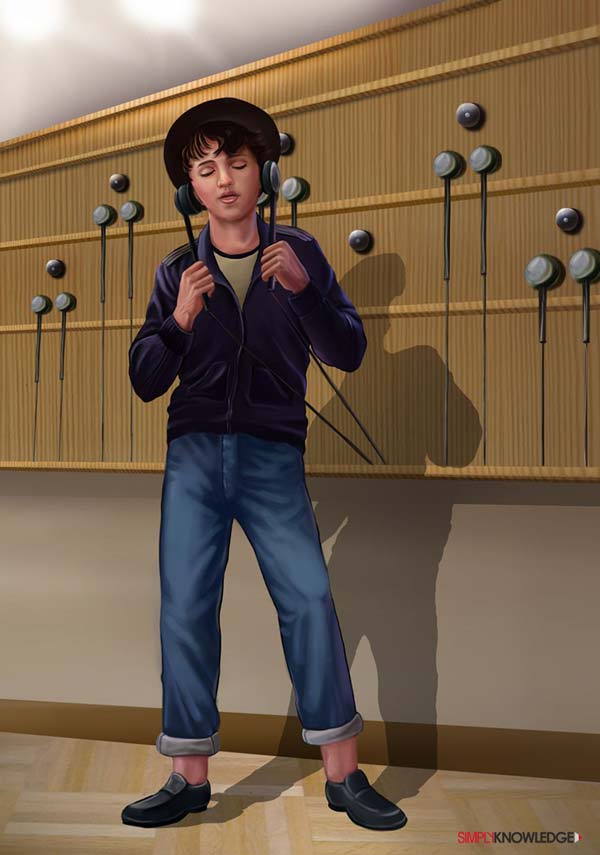
Elvis would on his own visit Beale Street to buy clothes. The flamboyant outfits at window displays of Lansky Brothers would leave him gazing, and his heart fluttered with a secret craving to wear them. Wandering around, he would engage himself with the latest modern and blues music at record stores, where jukeboxes and listening booths trained his musical ear. While the gospel songs from the white community church on Sunday mornings resonated in the air, Elvis would often accompany his parents to their gospel singing shows at the Ellis Auditorium, which ran throughout the night. Then at times, just like his white friends, Elvis would attend the blues music shows by black performers, when they were specially organised for the white community.

Elvis- A Good Natured Misfit
As New Year followed, Elvis was also seen with another group of friends from the Lauderdale Courts who formed a music band along with the Dorsey brothers. They would entertain people outdoors in the locality on summer evenings with country numbers. 15-year old Elvis rendered background vocals and attracted a lot of attention by the way he looked. Elvis kept long greased hair along with sideburns, just like the blacks, giving him the curious appearance of a rowdy truck driver. It sharply contrasted his immaculate politeness and courteous behaviour. Elvis, now in his tenth grade, was even bullied by some high schoolboys with malicious intent. Considering Elvis a misfit due to his peculiar looks and good manners, these troublemakers intimidated him, wanting to cut his hair and even beat him up.
Pretty soon, Elvis’ obsession for music and watching movies took priority. As a result, his school lessons were neglected and all his grades waned to a satisfactory level of ‘C’. Elvis left his football team that he had joined earlier, for the job of a part-time escort in the Loew's State Theatre. He used his earnings on bright flashy pink and black clothes, colours he wore from then on, and was later identified with. His emerging inclinations also gave him his earliest girlfriends in high school, Billie Wardlaw, Betty McMahan and Dixie Locke. Besides being with them, for the next two years Elvis also began playing his guitar occasionally at private parties, and would sing a Dean Martin, Perry Como or a Bing Crosby pop song. But his early singing style was mostly based on gospel songs, as Elvis was naturally inclined to the divinity surrounding them. This continued till the end of 1952, which brought new changes in Elvis Presley’s life.
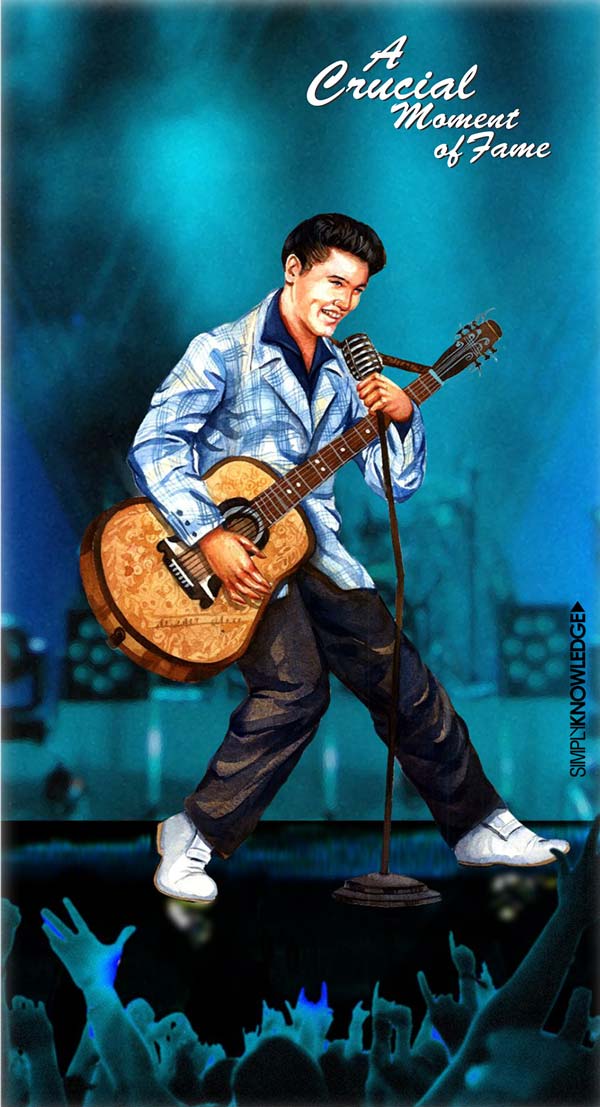
A Crucial Moment of Fame
After some more residence changes, 18-year old Elvis showed another new facet of him. At the Humes High Annual Minstrel Show, Elvis fought off stage fears and sang ‘Till I Waltz Again with You’, originally by Teresa Brewer. He won and his stage performance surprised everyone. It was a decisive moment as people came to know that this quiet boy could also sing. The youth were attracted to the lively young Elvis with strange looks, performing dynamically on the stage. Elvis Presley now felt happy with his new found acceptance among the public. Indeed, he was ordained to become a singing sensation. As he said later of this incident, “I wasn't popular in school ... I failed music—only thing I ever failed. And then they entered me in this talent show ... when I came onstage I heard people kind of rumbling and whispering and so forth, 'cause nobody knew I even sang. It was amazing how popular I became after that.”
In June, Elvis graduatedfrom high school with ‘Industrial Arts’, and immediately began working atM. B. Parker Machinists shop, seldom singing in public. Yet, by now he was sure that he wanted to make a career for himself in music, primarily wanting to be a gospel singer. So he began saving his money to pay for his recordings at Memphis Recording Service, an expensive and famous studio in Memphis, despite other cheaper studios around. Probably, Elvis had already heard of Sam Phillips eminence, and wanted to be discovered by him. Elvis was on the right path that would lead to fulfilling his wishes.

First Demo Song
Sam Phillips, a record producer and studio engineer, owned and controlled the Memphis Recording Service studio, later known as Sun Records. He was famous in Memphis for his new discoveries of talented Rhythm and Blues (R&B) singers and also recorded artists who sang country-western, commonly called hillbilly music. He assumed that ‘race music’, despite being sung by African-Americans, was liked and heard by numerous white youngsters in Memphis alone. Predicting the huge potential and success of R&B among wider audiences in the country, he would assertively state, “If I could find a white man who had the Negro sound and the Negro feel, I could make a billion dollars.”
The talented but inexperienced Elvis, who was nurturing his professional singing ambitions, now desired to get his voice recorded to feel its impact and for personal gratification. So, this 18-year old walked into Sam Phillips’ studio for the first time in August 1953. Phillips’ secretary enquired about his type of music and whom did he sing like. Elvis answered, “I don't sound like nobody.” Her inquisitiveness got the better of her as she taped him for her boss. It appears that Elvis was cognizant of Sam Phillips’ pronouncement. So perhaps to get noticed by him, Elvis recorded two songs originally sung by Ink Spots, a reputed R&B band. They were, ‘My Happiness’ and ‘That's When Your Heartaches Begin.’ It cost him four dollars, but Elvis had already worked hard to earn that money.
Elvis never heard from Sam Phillips after his first recording session. Elvis went back to the recording studio in January 1954. In Sam Phillips’ presence, 19-year old Elvis recorded ‘Casual Love Affair’ and ‘I'll Never Stand in Your Way’. Elvis did manage to generate an interest in Sam Phillips to some extent with his uncommon looks and sound, but all Phillips did was take down his contact number and address.

Elvis Awaits His ‘Big Break’
Amidst continuing night school, Elvis began another job at the Crown Electric Company as a delivery truck driver in April. Meanwhile, he also optimistically continued auditioning as a vocalist, looking for his ‘big break’. Unfortunately, he was rejected in two trial auditions, one being for the Songfellows (a vocal quartet) and a second where his friend Ronnie Smith sang. The leader of the band in the later audition even recommended that Elvis should continue truck driving, adding, “Because you're never going to make it as a singer.” This was a huge letdown for Elvis, especially when he needed approvals the most.
By mid-year, when Sam Phillips received a demo of the ballad ‘Without You’, he immediately considered Elvis to sing it. However, Elvis found the song difficult to pick up, so Phillips gave him a chance to sing whatever he could. Elvis happily sang from his broad collection of country songs as well as R&B, in his inimitable style. It was enough to sway Sam Phillips. Convinced, he suggested that Elvis collaborate with a guitarist Scotty Moore, and bring out some striking music. So, keeping pace with the 1950’s hot pink trend in men’s apparels, Elvis too wore a loud pink coloured shirt and trousers, along with white shoes and went to meet Scotty Moore. Moore played for the Starlight Wranglers. Together with bass player Bill Black, the trio frequently practiced in Sun Records. It was the era of the newly invented magnetic tapes which helped them to hit upon their sounds by taping, listening and tweaking for the next retake. They would soon arrive at their characteristic sounds that would begin a successful collaboration.
The three musicians spent the entire day of 5th July,1954, rehearsing unproductively at Sun Records till late night. While they indulged in a little tomfoolery during a break, Elvis began jumping and energetically rendering a blues number ‘That's All Right Mama’, originally by Arthur Crudup, one of the local Afro-American. Elvis crooned the song in a unique spontaneous manner and the other two joined in the fast-paced informal rhythm. Perplexed, producer Sam Phillips who was recording it from his control room quizzed, “What are you doing?” The trio didn’t know that they had finally discovered their new sound on that magical night, which would hook an entire generation. Phillips continued, “Well, back up, try to find a place to start, and do it again.” Phillips immediately acknowledged its value. Here, before him was a white singer who had an Afro- touch, singing rhythm and blues in an unheard-before style. The revolutionary sound that he had been seeking all this while was right in front of him in the form of 19-year old Elvis Presley.
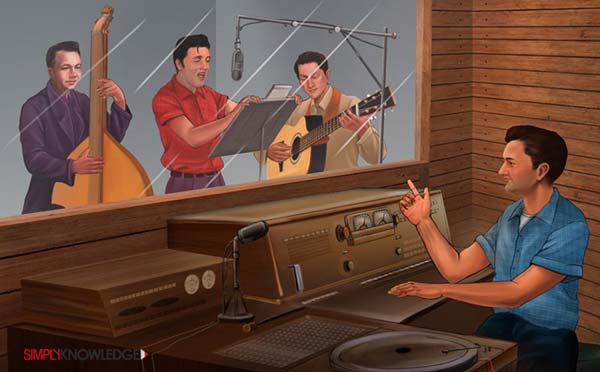
After a process of refinement, Elvis Presley’s first single, ‘That's All Right Mama’ was recorded on one side, while the flip side of the acetate disc contained a country music, ‘Blue Moon of Kentucky’ originally sung by Bill Monroe and the Bluegrass Boys. Elvis’ energized rendition of both these songs carried a more relaxed tempo and a vocal style that was far removed from the original African-American versions, bearing a stressed rhythm. Though he was not the first white to sing R&B, certainly Elvis was the first to blend them vigorously with country moods, into his unique sound to which Sam Phillips added the echo effect. This fast beat synthesis between country and R&B music, accompanied by powerful vocals of Elvis, gave birth to clean ‘rockabilly’ music, a style that Sun Records had the honour of producing. Elvis Presley now stood on the threshold of his meteoric career rise, and this was the biggest turning point in his life.

The Rise of A Legend
When he was 19, the trendy radio show Red Hot and Blue, that usually featured black musicians, saw a new song being played first time on-air, again and again; ‘That's All Right Mama’ by Elvis Presley. Dewey Phillips, popular disc jockey of Memphis was initially reluctant to play the unknown singer’s first single. When he received plenty of repeated requests by phone calls and telegrams to replay this Sun record, he obliged and initiated towards interviewing Elvis one night, to answer the curiosity of the callers.
A jumpy Elvis was cooling off his nervousness at the movies. He was picked up by his parents and dashed to the radio station WHBQ. Apart from answering a variety of questions, Elvis was tactfully asked by Dewey Phillips about his school name. On his answer ‘Humes High’, everyone was taken by surprise as they instantly knew that Elvis belonged to the white community in Memphis, and was not an Afro-American. Soon, 20,000 copies of Elvis’ first commercial singles ‘That’s All Right Mama’/‘Blue Moon of Kentucky’ were sold in Memphis alone, while people witnessed it rising up in the charts of country-western music by July end. Elvis Presley’s second record released after two months, which too featured an R&B song on one side, ‘Good Rockin' Tonight,’ and a country-western on the flip side, ‘I Don't Care if the Sun Don't Shine’. Within two-and-half weeks of release, 4000 copies of it were sold in Memphis, as it too rapidly scaled the charts, incidentally faster than the first single, a fantastic start for Elvis!
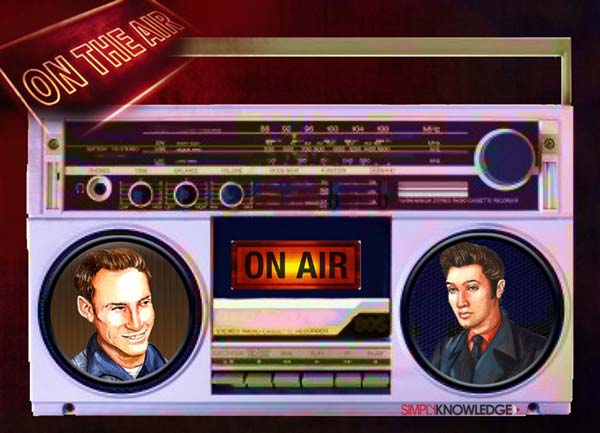
Elvis soon began performing live at night clubs with his first public appearance with his group on 17th July, 1954 with a group called ‘Elvis Presley and The Blue Moon Boys’. After initial management by Scotty Moore, Bob Neal, a disc jockey soon took over as their manager. Now began a series of performance tours, with Elvis being labelled as ‘the freshest and newest voice in country music’. Here, Elvis the upcoming artist who was rarely fatigued by the rigorous demands of his new career, began a weekly radio performance for a year’s contract, that was broadcasted to over 190 KWKH radio stations in America. It was a huge break for Elvis that ensured his rising popularity.
Elvis resigned from his day-job as a truck driver and purchased a new guitar, a Martin D-28 for $175 in place of his child-sized guitar. The Blue Moon Boys then welcomed drummer D.J. Fontana from Louisiana Hayride in their team, who matched Elvis’ body movements with his beats.

Success Kisses Elvis’ Feet
By early 1955, 20-year old Elvis Presley had gained regional recognition due to his records and his live performances with well-known performers. Then in February, Elvis was booked to sing at the all-star Jamboree Attractions. Here, Elvis got noticed by the show operator Colonel Tom Parker, an experienced promoter and manager of young singers. Colonel now began observing Elvis very keenly. On 3rd March, 1955, Elvis made his television debut on the broadcast of Louisiana Hayride show, on KSLA-TV. Three more single records of Elvis were released, that got airtime on radio stations solely dedicated to country music. The silver lining was his fourth record containing songs ‘I'm Left, You're Right, She's Gone’ and ‘Baby Let’s Play House’, released in April that reached the Billboard chart at No. 10, holding on for ten weeks nationally. Eddy Arnold’s country-western song ‘I Want to Play House with You’, fused with R&B in Elvis’ sensual style evolved into ‘Baby Let’s Play House.’ Elvis even altered few lyrics while Sam Phillips introduced drums for the first time in Elvis’ song. This song was the perfect selection for Elvis’ ‘rockabilly’ collection, which helped quickly build his countrywide reputation. Moreover, with his versatile voice, Elvis was also known to devotedly sing gospel, pop, bluegrass and operatic schmaltz, which cemented his newfound success and position as a musician and an entertainer.
Elvis’ earliest recordings are considered the first ‘rockabilly classics’ and his best recordings ever. Oddly, Elvis couldn’t read or arrange music professionally. He was a self-taught musician with no formal music training, so he copied the intonations and understanding of the demo vocalist for his song rendition. He always repeated the pattern of singing and recording songs with his musicians till he was fully satisfied. As his reputation soared, the term ‘rockabilly’ became a familiar word. But even before the word came to denote his non-conventional vocal style and his songs, amusing descriptions were presented by the media, who attempted to give explanations to the public. Interestingly, they suggested Elvis was a "white man...singing Negro rhythms with a rural flavour", "a young rural rhythm talent", "a young man [with a] boppish approach to hillbilly music", etc., that earned Elvis many more sobriquets.

A Blessing in Disguise
Alongside song recordings, the Blue Moon Boys continued extensive touring schedules with other country artists, as well as on their own within the country-western touring circle. At these live shows that continued all through 1954 -1956, Elvis was known to shake his legs while performing in a frenetic and forceful manner. His instinctive leg movements were especially accentuated by his wide-cut trousers, and this effect left a suggestive meaning that was misinterpreted as having sexual connotations, leading to the beginning of controversies. However, in reality, it was more a reaction to his stage fright due to huge crowds, and the rockabilly song’s rhythm to which he had to perform. With increased number of live shows, Elvis gained much confidence, and became equally mindful of the response he received.
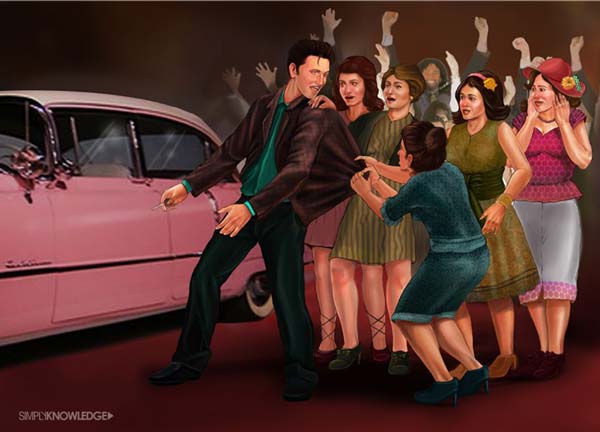
Soon, Elvis was being acclaimed for his peerless hip-swinging and swaying style. His body language, easygoing and candid manner of rendering ‘race’ songs, drew the basic picture of his music while his stage presence and performance institutionalized the grammar, lingo and visual representation of ‘rockabilly’ songs, setting its standards. This, along with his new sound in his deeply emotional and moody tone, gained attention among his youth audiences. By mid-1955, Elvis Presley’s spanking new voice had started a national storm. The song ‘Baby Let's Play House’ from his fourth single released earlier had provoking allusions. The teenage audiences gave thrilled reactions, especially girls who reacted hysterically to it. Elvis could make the girls yell by teasing them with his sexy body movements. He often caused a riot after shows, which he was unable to control. At times he had police protection. Once, after a performance in Florida, a flocking crowd of girls ripped off his clothes while chasing him to his car, in an outburst of excitement. It generated astounding reactions from the media and Gladys, Elvis’ mother was scared. But on the contrary, it delighted Colonel Parker, who was checking the attention this handsome boy received. Elvis considered his acts as natural, rather a result of the cultural inspirations from his predominantly black neighbourhood, where he grew up. He would say, “Rhythm is something you either have or don’t have, but when you have it, you have it all over.”
By now, Elvis Presley’s career was already on a high. Increasing appreciation from many quarters identified Elvis as ‘The Memphis Flash’, ‘The Hillbilly Cat’, and ‘The King of Western Bop’. Colonel Tom Parker was then appointed in August 1955 as Elvis Presley’s ‘special advisor’, who then began negotiating all of Elvis Presley’s contracts, as well as promoting him as the latest singing sensation.

Rock ‘n’ Roll Music
In early November 1955, Elvis Presley was awarded with ‘the year's most promising male artist’ at a Country Disc Jockey Convention, which garnered the interest of few record companies in him. By month end, Colonel, the shrewd businessman had facilitated a contract with the well-known recording company RCA Victor Records with his influence. Elvis was yet a minor at 20, so his father Vernon Presley signed on his behalf. RCA welcomed their talented new artist Elvis, who created a different genre of non traditional music, and gave him $5000 as bonus, a gift of a brand new convertible which his fans often defaced with their phone numbers, and a Gibson J200 from the manufacturer, his favourite guitar that he played well into the 70’s. RCA then began actively endorsing Elvis after re-releasing many of his songs recorded at Sun Records.
Meanwhile, a change in Elvis Presley’s singing style was underway even before his first RCA recordings began. His vocal style steadily kept evolving from ‘rockabilly’ to the hard-driven, power-packed rock ‘n’ roll, which soon gained popularity, especially amongst the rebellious teenagers who expressed themselves openly against power and dominance, by associating with this music. As these repressed teens found their meaning and voice in Elvis’s rock ‘n’ roll songs, they even began copying his hairstyle and clothes. Elvis became their idol.

An Eventful Year Begins...
The year 1956 was particularly eventful and critically important for 21 year old Elvis Presley, as he gained worldwide recognition as a ‘living legend’. Elvis’ electrifying performance while recording his first song ‘I Got a Woman,’ by Ray Charles, excited RCA’s in-charge, Chet Atkins who was playing a guitar. He immediately invited his wife to watch the Nashville studio recording session. Elvis’ second song recorded on the same day, ‘Heartbreak Hotel’ was his first single released in the same month under RCA that reached No.1 on the Billboard Pop singles after and also topped its country chart. Amazingly, it sold a million copies and was his first Gold record award.
To make the most of Elvis’ immediate outstanding success, Colonel soon brought him on national television with CBS's variety program ‘Stage Show’, starring Elvis’ friends, the Dorsey brothers. Elvis gave six appearances in two months beginning January. His popularity rose with his second appearance in early February where his performance to the tune of ‘Baby Let's Play House’, aroused controversies from the American public countrywide. Seemingly, his friendly interactions with the studio audiences on this family based television program saw many teenage girls screaming excitedly, applauding his highly charged music and hip-swinging style. Moreover, the singer’s ostentatious clothes from Beale Street, ducktail hairdo with pomade and long sideburns created a more dramatic effect on his animated feat with provocative overtones, which seemed inappropriate for family audiences.
Around this time, articles involving rock ‘n’ roll and juvenile delinquency surfaced in popular print magazines, linking them together. Elvis was becoming rather infamous, yet he distinctly outshone all previous entertainers on the CBS’s Stage Show and every following episode received better TV ratings than his preceding one.
Soon, a second RCA recording session involving eight rock ‘n’ roll numbers followed in New York where his famous songs ‘Blue Suede Shoes’ and ‘I Forgot to Remember to Forget’ were also recorded. Selected songs from the Nashville and New York sessions along with few unreleased songs from Sun Records were pooled in to form Elvis Presley’s first RCA long-play (LP) album. Titled ‘Elvis Presley’, this million-dollar album went public on 13th March, 1956, and became the first successful full-length album in the history of music that sold a million copies. It gave Elvis his first Gold album award and reached the top position of Billboard Top LP chart.
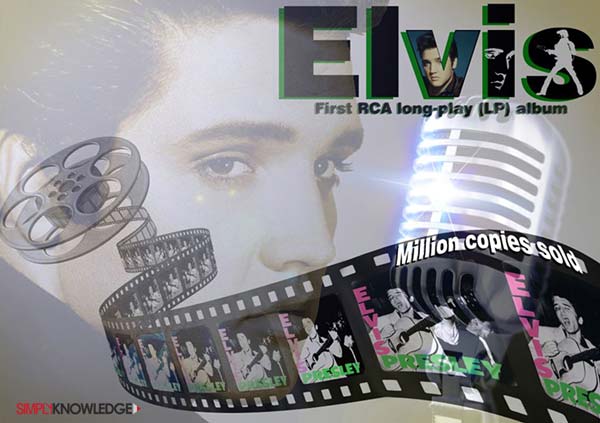
As Elvis slowly grew as an artist, his first album distinctly showed him drifting away from pure ‘rockabilly’ towards conventional rock ‘n’ roll, which had a racier and explosive sound. Critics, who didn’t favour this move, were now opining that Elvis’ commercial association with RCA degraded the quality of his songs, while the general audience just viewed it as a modification. However, Elvis was least concerned, as more than anything else, he just wanted to hog the limelight and be extremely successful like his icon, Dean Martin.
Colonel Parker formally became Elvis Presley’s only manager from March 1956, commanding a share of 25 percent profits in return. By then, six record singles of Elvis were among the top 25 Best Sellers list of RCA. Colonel then gave more momentum to Elvis’ now in vogue rock ‘n’ roll music with live concert tours in the North, where spectators were unfamiliar with Southern music. Elvis also took mid-west tours of 15 cities, where he repeatedly drew wilder crowds who created havoc at his live stage shows, often leading to early endings.
Early that year, Colonel Parker had also established two new music companies, Presley Music Inc. and Gladys Music that had the rights to all songs of Elvis Presley. So, Elvis and Parker actually went ahead with the music modifications from ‘rockabilly’ to rock ‘n’ roll for promotional reasons, which protected their partnership contracts and commercial interests of Hill and Range, their music publisher allied with RCA. Though Elvis is not known to write any songs in his lifetime, lyricists under Hill and Range’s employment had to acknowledge Elvis as a co-writer. In return, the lyricists earned a lot, despite a third of their royalties being given to Hill and Range as the songs began selling in millions. This smart business move benefited monetarily, as Elvis received royalties for performing live shows as well as from publishing records for RCA.

Hollywood Beckon Elvis
Elvis, the leading singer was actually eager to act in the movies ever since he was a theatre escort in school. He often said, “Singers come and go, but if you're a good actor, you can last a long time.” Now, an acting career that Elvis often imagined was just round the corner. Veteran Hollywood movie producer Hal Wallis noticed Elvis Presley first on one of the ‘Stage Show’ TV episodes and his performance won him over. But what caught his attention was Elvis’ magical effect on the studio audiences, as his female fans over-reacted to his teasing charm. Wallis instantly figured that Elvis was star material and immediately scheduled Elvis Presley’s screen test on 1st April, 1956, in Hollywood. Elvis then signed a seven-year contract with Paramount Pictures, which gave him an opportunity to fulfil his acting ambitions. Hal Wallis placed tremendous confidence on Elvis, then a newcomer in the movie business. So Hollywood too gained faith in Elvis. Wallis then loaned him to Twentieth Century Fox for ‘The Reno Brothers’, as initially there was no appropriate role fitting Elvis. Though he did not get top billing, it was definitely the beginning of a flourishing movie career for Elvis.
Since shooting for ‘The Reno Brothers’ could only begin after four months, the ‘Milton Berle Show’ for NBC was the next in a series of television performances. The same month, Elvis was also booked on a four-week Las Vegas trip and he performed at the New Frontier Hotel and Casino. Here, the conservative adult audiences could not identify with Elvis’ music. Moreover, they were shocked and displeased at the crude nature of his acts and gave him a poor response. Elvis’ flop entertainment show cut short his live concerts to two-weeks. Elvis then used his Las Vegas time to hear the Bellboys and their lead singer Freddie Bell deliver their humorous version of ‘Hound Dog’ at a show. Soon, Elvis adopted this bluesy beat to his closing performance. ‘Hound Dog’, originally sung by blues singer Big Mama Thornton, would later become one of Elvis Presley’s signature rock ‘n’ roll songs.

‘Elvis the Pelvis’
On 5th June, 1956, Elvis Presley appeared for the second time on the Milton Berle Show, where he gave an energetic performance of the new song ‘Hound Dog’, first time on television with swivelling hips and legs, gyrating motions, pelvic thrusts and hand gestures. His act generated a huge commotion, making the audience go wild nationwide. By then, the rock ‘n’ roll singer had become famous for his uninhibited stage performances, and he even had loyal teenage fans. Now, Elvis, along with his gaudy Beale Street outfits, distinctly Southern accent, unusual hairstyle and explosive rock ‘n’ roll music was denounced as vulgar by several parents and religious groups, who linked it to reckless adolescent behaviour. Elvis objected saying, “It's only music. In a lot of papers, they say that rock ‘n' roll is a big influence on juvenile delinquency. I don't think that it is. I don't see how music has anything to do with it at all....I've been blamed for just about everything wrong in this country.”
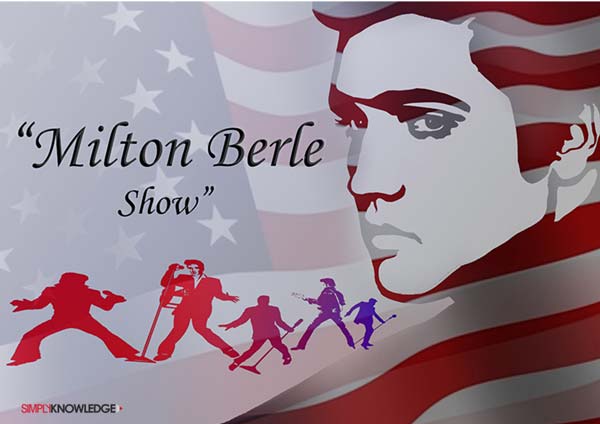
Arguably, this second Berle show was Elvis Presley’s most contentious performances that invited a lot of flak from the press, media and adults viewers, who equated it to a striptease! He was now being ridiculed and nicknamed as ‘Elvis the Pelvis’. Moreover, Ed Sullivan a TV industry bigwig was disgusted. He publicly announced that Elvis was ‘unfit for family viewing’, and refused to book him on his Ed Sullivan Show, without the faintest idea that soon, he would have to change his mind.
The blaring controversy surrounding the Milton Berle Show only amplified Elvis Presley’s image as a notorious rock ‘n’ roll star. In fact, its enhanced television ratings gave Elvis an invitation on NBC’s The Steve Allen Show, a rival of the popular Ed Sullivan Show. The anchor Steve Allen, however loathed rock ‘n’ roll music, opining that unnecessary attention was being given to the eccentric Elvis. Thinking Elvis would repent for his previous acts, Allen had set it up for him, and presented Elvis on his show dated 1st July, 1956, as ‘the new Elvis Presley’ wearing a top hat, white bow tie with black tails, and a tuxedo. Allen even made Elvis sing ‘Hound Dog’ to a basset hound dog. Good-natured Elvis didn’t protest, but performed with a gloomy look, as his movements too were restricted. Later, he said that this was his ‘most ridiculous performance’ till date. The next day, Elvis Presley’s followers protested against his singing act with placards to NBC studios that read, “We want the gyratin’ Elvis.”
The Steve Allen Show overtook the primetime Ed Sullivan Show in TV ratings, proving that Elvis Presley was a sure shot entertainer to whom live audiences were drawn. Ed Sullivan then slowly mellowed his position on Elvis, and gave him the opportunity to appear on Sullivan’s show after two months.
He subsequently featured on another program the same day called ‘Hy Gardner Calling’, a local talk show hosted by columnist Gardner. On being questioned by Gardner on the day’s early performance of ‘Hound Dog’ and his lessons from the condemnation, Elvis retorted, “No, I haven't, I don't feel like I'm doing anything wrong ... I don't see how any type of music would have any bad influence on people when it's only music ... I mean, how would rock ‘n' roll music make anyone rebel against their parents.” This show helped dispel the nasty myths and superficial airs about him. The general public now viewed him as a down-to-earth person with mixed feelings on his achievements. Elvis reacted with, “I don't like being called ‘Elvis the Pelvis’ – I mean it’s one of the most childish expressions I ever heard, comin' from an adult.” Clearly, on this show, a very positive image of the ‘other Elvis’ emerged in the media.
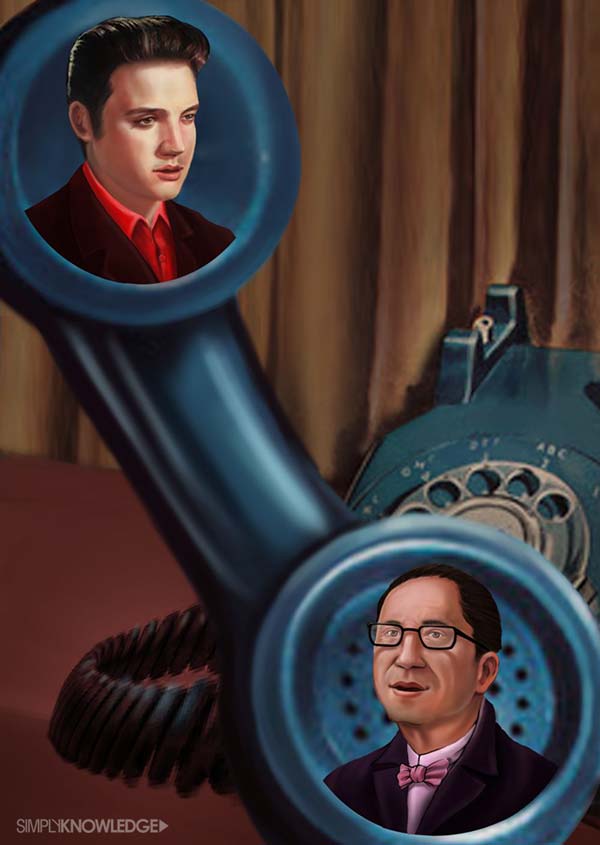
In the press, the ‘other Elvis’ was now being written and talked about as a responsible person. Stories also included his closeness to his parents, absence of bad habits like smoking and drinking, as well as his charming, well-mannered disposition where he treated elders with respect. The rising singer always acknowledged his parents for his success saying, “I never felt poor. There was always shoes to wear and food to eat – yet I knew there were things my parents did without just to make sure I was clothed and fed.” Colonel Parker would publicise his compassionate stance towards the underprivileged, whenever Elvis donated to charitable organizations. Moreover, he constantly depicted Elvis as a teenage icon united to youth sentiments. So the ‘other Elvis’ showed up in children’s merchandise like T-shirts, lunch boxes, and in teenage feminine collectibles such as ‘Elvis Presley bracelets’ and lipsticks such as ‘Heartbreak Pink’, ‘Hound Dog Orange’ etc. Industries made commercial success selling sweaters, jeans, belts, cologne, hair pomade, bubblegum cards etc., associating them with Elvis. Of course, Colonel Parker and Elvis started new trends, and set standards in the domain of celebrity merchandising.

Silver Screen Debut
After the Steve Allen Show, Elvis Presley recorded his famous rock ‘n’ roll signature songs, ‘Hound Dog’ and ‘Don’t be Cruel,’ after almost 30 takes. ‘Don’t be Cruel’, his most favourite song had remained unsung by any singer so far, and was completely rendered in his new tune and style. The Recording Industry Association of America (RIAA) awarded both these popular songs with a triple platinum status after three and half decades. Certainly, Elvis Presley, can be credited for popularizing rock ‘n’ roll music.
In August, there were two live concerts in Florida. Elvis also formally made the career transformation from a musician to a movie star in August, when he began acting for his first role as Clint Reno in the movie by Twentieth Century Fox ‘The Reno Brothers’. The producers re-thought his on screen death in the movie, as they were apprehensive that it may not appeal to his fans. So keeping the storyline intact, they re-shot the concluding emotional scene with a more positive image of Elvis’ character, singing the main music track ‘Love Me Tender’. This song was first released by Elvis as a single record, but after it got revealed to audiences on the first episode of Ed Sullivan Show, it received more popularity, and the single got a path-breaking two million copies advance orders. This promptly led the producers to rename the movie to ‘Love Me Tender’ beforeits release. This was Elvis Presley’s earliest beginning as a successful movie star.
September 1956 began with Elvis Presley’s recordings for RCA’s second album ‘Elvis’ at Hollywood. Then, Elvis appeared as a guest again on the Ed Sullivan Show. Elvis was offered an unmatched remuneration of $50,000 for three episodes beginning9th September. In the first two episodes, a restrained and carefully guarded camera movement captured his studio performance. But his final appearance in the next year, on 6th January, 1957, created one of the most memorable minutes in the archives of the early television era. Elvis, who was wearing loud and unusual clothes, was shown only above his waist in all the three segments!!!
All the three episodes were interesting, which received the customary overexcited screams and applause from the studio audiences. But Ed Sullivan’s compliment on the final show that Elvis was ‘a real decent, fine boy’, ironically appeared deceitful when Elvis’ entire body movements were actually censored. It became famous in rock history for causing huge controversies. Nevertheless, Elvis received status as a contemporary national celebrity, receiving sensational fame with his performance on thishitshow that hooked 80% of the American audience to their television sets.
The year 1956 continued to be eventful for Elvis. 26th September was declared as ‘Elvis Presley Day’, in the town where Elvis was born, Tupelo, Mississippi. By now he was a famous man and was welcomed to his hometown with a parade in his honour. On this visit, he performed twice at the Mississippi-Alabama Fair and Dairy Show, where he had first performed as a 10-year old kid. Elvis carried on with his work, and was now waiting with baited breadth for the release of his first movie on the silver screen.
A considerable crowd showed up to see the gigantic promotional cut-out of Clint Reno, Elvis’s character in his Hollywood debut ‘Love Me Tender’, atop a New York theatre. Elvis Presley’s first movie premiered that day of 15th November, 1956, in New York, and released days later. ‘Love Me Tender’ established Elvis Presley as an actor. It was the beginning of his box office hits, where Elvis would receive top billing thereafter in all his remaining movies. All four successful soundtracks were sung by Elvis, and the album released as an extended play (EP) by RCA. Since then, producers designed musical ‘movie vehicles’ for Elvis.
It was also a marvellous year for the sale of Elvis Presley merchandise, almost to the tune of $22 million, as the Wall Street Journal reported. But the icing on the cake was the fame and glory Elvis received on his career makeover, as a widely acclaimed entertainer and a superstar in the movies.

Elvis Phenomenon Is Captured In Movies
Aged 22, Elvis began filming his second movie ‘Loving You’. This movie was Elvis’ first musical ‘movie vehicle’ to highlight his singing talents and also depict his life story. It connected Elvis to his roots, as his character Deke Rivers was shown as a talented, but unknown singer from the South, from where he rises. The director managed to portray the darker side of being Elvis Presley, the singing sensation, who was constantly surrounded by his hysterically screaming and attention seeking fans. In fact, the director attended one of the last Louisiana Hayride concertperformances of Elvis Presley, to understand the phenomena called Elvis and his real experiences amidst public frenzy.
For the filming, Elvis dyed his dark blond hair black. As he missed his parents company in Hollywood, so they joined him on the sets of ‘Loving You’ and even made a brief cameo appearance, along with his assisting musicians Scotty Moore, Bill Black, D.J. Fontana and the Jordanaires quartet who provided back-up vocals. With this hit soundtrack album, RCA began the formula of combining songs from Elvis Presley’s recordings with his releasing films, and publishing them as albums. Colonel Parker’s thoughtful publicity saw that Elvis’ on-screen movies acted as advertisers of his records, albums and vice-versa.
Colonel Parker’s managing of Elvis Presley’s challenging career also made them exceedingly rich. Elvis was now living a better life with his parents at Audubon Drive in Memphis, a residential neighbourhood. But here he was constantly bothered by his fans who constantly demanded his attention. An unpretentious Elvis never denied his fans access to him, and always remained thankful to them for their love. However, Gladys did not like the change in their lives, where they were not only sacrificing their privacy, but her son’s lifestyle was steadily becoming uncommon and fast-paced. By now, Elvis was surrounded by a rowdy group of friends named, ‘the Memphis Mafia’ who were there to protect him at any time from the crowd. Around that time, Elvis successfully passed a pre-army-induction physical test at a Memphis hospital. The event prepared Elvis to expect the draft notice announcing his induction into U.S. military service sometime in the year.
In March 1957, Elvis bought Graceland Mansion at Memphis for $102,500. This mansion stood on an estate of 14 acres, just perfect for Elvis who was now a big celebrity. This was also the year when Elvis took three tours, giving five performances in a different country, Canada. Elvis then embarked on another filming journey for his next film ‘Jailhouse Rock’ that was equally successful like his previous two films. By now Elvis had a habitual crush on all his female co-stars, though he had amiable relationships with his male co-stars. He also began seeing Anita Wood, a TV performer, who would continue as his girlfriend for the next five years.
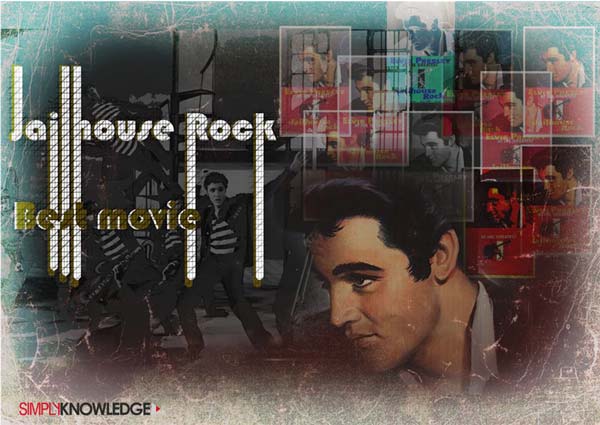
Jailhouse Rock for MGM Studios was Elvis Presley’s third movie that began filming on May 1957. With most songs written by Otis Blackwell, this memorable EP album, held the no.1 position for 28 weeks during the winter of ‘57-‘58. This low budget movie was considered Elvis Presley’s best movie, where he delivered an excellent acting performance. It is also best remembered for his electrifying dancing feat, to the tune of the title track ‘Jailhouse Rock’ written by the renowned rock songwriters Jerry Leiber and Mike Stoller, who soon became good friends with Elvis.Elvis developed his dancing style with the help of coach Russ Tamblyn. But Elvis also choreographed this song with choreographer Alex Romero, in his usual vibrant style. This hard-rocking song gave the perfect example of Elvis Presley’s image as the ‘King of rock ‘n' roll’; while the movie portrays the untamed nature, spirit and sexuality of his rock ‘n’ roll music, that seemed to influence the youth culture.
Before Christmas, Elvis Presley recorded his best selling Christmas album titled ‘Elvis' Christmas Album’. His ‘good luck charms’, as he considered Leiber and Stoller, wrote a blues song ‘Santa Claus Is Back in Town’ that became widely popular. After the recording, his companions, D.J. Fontana, Scotty Moore and Bill Black soon resigned as regular members, though later they continued for few recordings on a freelance basis. Around this time, Elvis received his draft notice from the Memphis draft board, informing that he would soon be inducted into the U.S. Army next year. Elvis deferred his induction by over two months, to prevent irreversible losses to Paramount Pictures and Hal Wallis, who had invested almost $350000 in ‘King Creole’, that Elvis would now be engaged with.
Beginning 1958 till early March, Elvis was busy recording soundtracks and acting in his fourth movie ‘King Creole’. This musical was based on the novel, A Stone for Danny Fisher by Harold Robbins. Production values for this movie were extremely high. The movie had a first rated star cast amongst whom Elvis, with his polished acting talents, managed to stand on his own in the role of the singer Danny Fisher. With excellent reviews from critics, King Creole was enough proof of Elvis’ hidden acting potential and talents.

In The Service Of The Country
Soon after 23-year old Elvis finished his duties for King Creole, he was inducted into the U.S. armed service on 24th March, 1958. Now, as Private Elvis Presley, he headed towards Fort Chaffee, Arkansas. His tearful parents, girlfriend Anita Wood and others saw him off. Though he seemed positive and wanted to prove his loyalty to his countrymen, thoughts about ruining his career bothered him. The news that Elvis would cut his famous ducktail hair and sideburns, troubled his fans more, even making headlines. Elvis chose to serve as a regular soldier, an ordinary civilian and not a celebrity with special privileges under ‘Special Services’. Colonel Parker had convinced Elvis to take this position to ward off negative publicity. Elvis too wanted to be seen in a new light after his military stint. But this decision did not make life in the army any easier. He missed home and often called up Gladys with tears in his eyes to baby talk as always. Despite his reassurances Gladys too found it extremely difficult to bear her son’s long absence. By May-end, Elvis finished his basic training and was classified as a sharpshooter. In fact, as he was fond of guns, he did extremely well with pistols. Then, he was granted leave for two weeks in June to visit his anxious family, during which Colonel Parker also kept him busy recording songs for RCA at Nashville.
After his return to Fort Hood, Elvis received permission and moved to a temporary trailer home close to his base, to live with his family and extended family members, who often came over to visit him. This homely boy was now pretty peacefully settled within the comforts of his normal family life, till his mother’s health showed worrisome signs of deterioration. Gladys remained hysterical about her only child’s well being and became unwell. On returning to Memphis with Vernon Presley in early August, she was diagnosed with severe hepatitis and passed away on the morning of 14th August, 1958, after a heart attack, at the age of 46. Elvis who was granted emergency leave to meet his mother two days earlier, now cried inconsolably at her Forest Hill Cemetery site. His mother was his closest companion whom he deeply revered. Gladys’s death left Elvis deeply distressed. After his personal loss, Elvis no longer desired to watch ‘Loving You’, as it reminded him of his loving mother
Elvis finally returned to his base at Fort Hood on 24th August, 1958, and soon began picking up the threads of his life all over again. However, within a month, he was bound for Europe, to a country formerly called West Germany, aboard the USS General Randall, where he entertained fellow recruits. Soon, his father Vernon, his grandmother Minnie Mae and few friends from ‘Memphis Mafia’ joined him, giving Elvis much welcomed company.
All through the last two months of 1958, Elvis performed extensive field manoeuvres to avoid being recognized by the common public. He was soon promoted to Private First Class for excelling and would be heard saying, “The army teaches boys to think like men.” He also diligently began learning karate, an interest that he retained beyond his army years, as he would later incorporate karate moves into his stage performances of the ‘70s. Around this time in Grafenwohr, a Sergeant led him to begin the use of amphetamines, drugs needed to stay awake for longer periods of training. Before long, it had formed a habit for Elvis. Prescription drugs would pose a tremendous health problem in his final years.
Elvis would donate his salary to charity and even buy television sets and other essentials for the army base. He also engaged in his hobbies after work, like playing the piano and football. Meanwhile, his two-year break was cautiously planned by RCA producer Steve Sholes and Colonel Parker, who continued to keep Elvis’ career thriving. In preparation, before his army service, they saw to it that Elvis recorded plenty of unreleased songs for RCA. While most songs released during his hiatus were successful, ten songs from among his record releases were among his top 40 hits. Taking cognizance of Elvis Presley’s hugely successful first four movies, Colonel Parker too was busy engrossed in negotiating for Elvis at Hollywood studios, preparing for his homecoming.

Elvis Meets His Future Wife
Elvis managed to spend his most normal life during his army days, away from the busy life of a celebrity amidst show-business cacophony. It was in these normal army days that Elvis met his future wife. 14-year-old Priscilla Ann Beaulieu was the step daughter of Air force Captain Joseph Paul Beaulieu, who had joined the Wiesbaden Air Force Base near Friedberg in Germany. He was transferred from Texas and arrived sometime mid-August 1959 with his wife Ann Beaulieu and children. As an infant, Priscilla had lost her biological father James Wagner, a Navy Pilot, in a plane crash. Elvis, now a handsome 24-year old soldier, was introduced to Priscilla by a common colleague, Currie Grant from the U.S. Air force on Sunday, 13th September at Elvis’s home. Elvis was instantly charmed by this beautiful young teenager in the ninth-grade, and took a liking for her. But this well-mannered man had to initially win over her parents, explaining his well-respected intentions. Before long, they began dating in Elvis’ home amongst his family folks, away from prying media eyes. Priscilla was mature for her age and filled the deep void that Elvis felt after his mother’s death in his final months in the army in Germany.
As his army days drew to an end, Elvis was promoted to the rank of Sergeant, and was officially discharged from duties on 5th March, 1960. After two days, Elvis arrived at his home in Graceland. The headlines were screaming loud ‘The Army's Made a New Man out of Elvis’. Elvis continued his long distance relationship with Priscilla and began concentrating on reviving his career.

Elvis’ comeback
On his return to America in the early ‘60s, Elvis noticed that the music scenario had changed. Taking into consideration the prevalent music trends, Elvis and the Colonel designed and promoted a fresh new image and sound of Elvis. Elvis Presley’s past controversial image as the rebellious ‘rock ‘n’ roll’ singer was abandoned for his new, matured reflection as a positive and responsible ‘pop’ singer, and his long ducktail hair too was done with. Methodically, they designed their campaign around Elvis’ new changed persona utilizing diverse media channels. This image makeover was a right career decision at this point, as it drew a wider audience appeal. Besides, it also seemed beneficial from the financial view, given that this non-controversial representation also endorsed Elvis’ forthcoming movies.
Two weeks after his return from Germany, Elvis cut many songs for his latest unusual album ‘Elvis Is Back’, which released in April end the same year. His music united diverse genres effortlessly, that mirrored his confidence in his strong, refreshing voice. He now regained acceptance from adult community members as a conventional pop singer. While ‘Elvis Is Back’ reaped success even at an international level, the solo track ‘Stuck on You’ became a number one hit within three weeks. The media too showered praises on the mellowed down Elvis. Many fans lamented the downfall of pure rock ‘n’ roll, though most acknowledged it as his mature and stable progression.
Frank Sinatra’s variety show on ABC-TV, Frank Sinatra Timex Special marked the re-entry of Elvis on television. This Elvis special titled episode ‘Welcome Home Elvis’ aired on 12th May, 1960, was recorded about a month and half earlier, for which Colonel Parker had negotiated an astonishing figure of $125,000 fee, even before Elvis was discharged from the army. This show where Elvis appeared with four other guests, received an outstanding response, given that Frank Sinatra had previously rebuked Elvis’ rock ‘n’ roll music.
Dressed in a conventional tuxedo with a short hairstyle, Elvis showcased his changed image as a pop singer. This signified a new role in Elvis’ life, where ‘the Voice of the ‘40s’ that Frank Sinatra identified with, was surrendering his position to the new ‘King’ of pop, who became ‘the Voice of the ‘60s’. Predictably, the show received mammoth viewership.

Elvis Returns to Hollywood
The change in Elvis Presley’s image in the movies post his army stint was brought about by starring in a chain of formulaic musical ‘movie vehicles’, beginning with ‘GI Blues’ for Paramount Pictures, which commenced production in late April 1960. Critics gave excellent reviews as the movie and its album were exceedingly successful, making him appeal to older family audiences. In fact, the ads targeted the family audience as ‘See and Hear the New Elvis: The Idol of the Teenagers is the Idol of the Family.’
Elvis however, didn’t quite revel in the success of ‘GI Blues’, and was less interested in such formulaic ‘musical comedy movies’ that followed. The problem Elvis felt was that while there were too many songs, their lyrical quality was poor. Some of them even looked artificial within the plot. Moreover, Elvis patiently kept waiting for his most challenging role as he had envisioned about his Hollywood career.
The month of July did bring Elvis some good news though, one being his father Vernon, who got married to divorcee Dee Stanley, a lady he had met back in Germany. Soon after Elvis got his first degree black belt in karate, his wish came true. Beginning August 1960, Elvis got an opportunity to work in the next two dramatic movies, ‘Flaming Star’ directed by Don Siegel with an interracial subject, and ‘Wild in the Country’ a drama, directed by Philip Dunne. These movies gave Elvis the chance to prove himself as a serious actor, where he was certainly noticed for his fine histrionics. But though they didn’t show any financial loss, they weren’t commercially rewarding either and therefore, Elvis was compelled to return to the ‘musical comedies’. Furthermore, his screen performances let down his fans, who bestowed upon him the following year with ‘the most disappointing performers of 1961’ and Damp Raincoat Award by Teen magazine. This thwarted his expectations of ever shining as a serious actor in a melodramatic role. The realisation now dawned on him and Colonel Parker that his fans could not digest his serious persona.
By October 1960, ‘GI Blues’ soundtrack album was fixed to the number one slot. It was followed in December by the massive success of Elvis’s first LP gospel album ‘His Hand is Mine’. By the following year, his albums had recorded worldwide sales figure of over 75 million, an astonishing feat for Elvis who was just 26! Shortly, he also performed two live concerts for charities and their concerns. On 25th February, he benefited nearly 38 charities in Memphis with two shows at the Ellis auditorium. A second live fundraising charity concert followed on 25th March, to build the USS Arizona Memorial in Pearl Harbour, Hawaii. Elvis generated huge awareness about the mission and managed to raise in excess of $52,000. His noble gesture was certainly appreciated with official credits, while he received more respect from wider audiences. Throughout his life Elvis was quietly involved in many philanthropic activities that remained an unknown affair. He even paid off any debts for his family, friends and at times even for unfamiliar people. Expensive gifts such as Cadillac cars and jewellery were commonly given to his family, friends and associates. But all he said was, “Money’s meant to be spread around. The more happiness it helps create, the more its worth.”

Presley Travelogues
Elvis Presley’s management now only wanted to promote Elvis in soundtrack formulaic movies and target mainstream viewers. They belittled his role as a modern, revolutionary musician. Elvis was starring in atleast three movies a year, a gruelling movie-making schedule. Then as the ‘60s progressed, he briefly discontinued the non-soundtrack album recordings and his live concert appearances as his focus was solely on his movie career. With his next musical comedy ‘Blue Hawaii’, there was a further narrowing down on the type of movies Elvis would be starring in. Blue Hawaii was a model musical comedy featuring 14 soundtracks with a blend of rock and pop music. Hal Wallis had specially tailored it for Elvis. It was widely regarded as Elvis Presley’s best musical comedy that firmly established his formula for success in Hollywood. This movie restarted his popularity trend. Blue Hawaii was also his biggest-selling soundtrack album, selling 2 million records within the first year of its release. RIAA awarded it the status of double platinum in March 1992. This movie and similar light-hearted musical vehicles that followed were known as the ‘Presley travelogues’, which was a total family fare characterised by youthful delights and pursuits, fun-filled entertainment in exotic locations, romance, girls, and a breakaway from the hum-drum of daily life.
With the movie ‘Kissin’ Cousins’, filmedaround October 1963, the filming schedules for ‘Presley travelogues’ grew shorter and the budgets reduced along with a decline in their production values. Hal Wallis, who made these low budget movies would openly state that a ‘Presley’ movie guaranteed success. Elvis began feeling utilized and grew increasingly uninterested as his silly, but lucrative movies began to upset him. Few of these movie soundtracks were hits on the pop charts in the first half of the ‘60s, but their soundtrack quality too declined progressively. Moreover, Elvis’ contract with his music publisher Hill and Range burdened him with shoddy songs and lyrics from mediocre lyricists. These ‘Presley travelogues’ did not contribute much to Elvis’ music reputation, yet he always gave his best. In reality, they hampered his acting potential and critics damned his Hollywood career.
During this unhappy phase of his life in Hollywood, Elvis met Larry Geller in April 1964, who became his hairdresser. Larry introduced Elvis to spirituality and guided him in his quest to find a deeper meaning of life. Spirituality gave Elvis the strength to withstand his troubled professional life which was devoid of any creativity.

Romance and Marriage
From amongst Elvis’ poor quality movies were some unbeaten and worth mentioning ones. His 15th musical movie Viva Las Vegas is distinct for his on-screen chemistry with his co-actress Ann-Margret. The actress was known as ‘the female Elvis Presley’, as she could sing and match her energetic dancing moves along with Elvis’ in her own mind-blowing style, with panache. She made an explosive pair with Elvis on-screen that led to publicity mills producing news of their ongoing off-screen romance.
Elvis’ affairs with his co-actresses were publicised often in entertainment magazines, etc., in order to garner interest in his projects, but they were typically made-up or futile. Besides, his personal life was well guarded and kept out of audience sight, thanks to Colonel Parker, who opposed the idea of Elvis being in a dedicated relationship to safeguard his steady movie career. So while Elvis continued dating Anita Wood and several Hollywood actresses, he carried on courting Priscilla Beaulieu over the phone till she arrived on the scene in America by the end of 1962. Anita then moved on as Elvis and his family took charge of Priscilla’s high school education from Memphis, a promise Elvis had given to her parents. Priscilla soon began living a private life in Graceland with Elvis’ grandmother Minnie Mae, since Elvis was mostly away in Hollywood. Priscilla being a minor then, Elvis carefully managed to keep her out of public eye and finally married her on 1st May, 1967, after nearly seven and half years of courtship. Elvis was then 32 years old, while Priscilla was almost 22. Though briefly, marriage gave Elvis a happy distraction from the disturbing trend of releasing poor soundtrack albums and their low-budget money-spinning movies that continued in rapid succession throughout his Hollywood career.

First Grammy Award
By early 1966, Elvis music interests had revived to an extent. So he invested in musical equipments at home and began experimenting with folk music. Soon, Elvis also recorded for his second gospel album, ‘How, Great Thou Art’ at RCA’s Nashville studio in mid-May. Now, Elvis had on board a new producer Felton Jarvis as well as new musicians, notably his favourite gospel groups: the Statesmen and Blackwell Brothers, the new group Imperials, and the Jordanaires. Elvis was extremely elated to sing gospel with them as it helped him rise and heal his spiritual being. They also revved up his creative talents, and soon, Elvis regained his joie de vivre. Elvis reached a landmark in his singing career when he received the prestigious Grammy Award in the Best Sacred Performance category for this second gospel album in February 1967. Certainly, Elvis felt deeply rewarded for his efforts as this helped him put his stagnant movie career at the back of his mind.
By now it was noticeable that Elvis Presley’s Hollywood career was spiralling downwards. Not one of his soundtrack albums charted anywhere near the Top 20s in 1967. Besides, the Hollywood ‘musical comedy’ formula too had reached a blind alley. Slowly, Elvis’ on-screen glory waned and the box-office earnings too reduced. Elvis now had enough, and felt it was time to quit from this unfulfilling profession.

Elvis Finds His Way Home
The following year brought Elvis great personal joy as he became a father on 1st February, 1968. Elvis proved to be a doting dad to his one and only girl, Lisa Marie Presley. Always extravagant in his lifestyle, a few years later, Elvis bought a Convair 880 Jet and named it ‘Lisa Marie’ after her. But his relationship with his wife Priscilla had begun to show cracks. So amidst filming and soundtrack recordings, Elvis now decided to return to his foremost love that would keep him happy, his music and live concerts. Contractual liabilities however, prevented Elvis from quitting movies immediately, and moreover, Elvis was little apprehensive about performing in live concerts after seven years. However, he regained his confidence after seeing the Welsh singer Tom Jones performing solo at Las Vegas and receiving a good response.
Meanwhile, an arrangement with NBC-TV was worked out by Colonel Parker to bring 33-year old Elvis the entertainer, back on television. Director Steve Binder and his production team then weaved a script to tell the story of Elvis Presley’s musical journey, his trials and tribulations in Hollywood and finally his return to his heavenly world of music. Elvis worked wholeheartedly for this 60-minute special titled ‘Elvis’ which featured his live performance and informal jam sessions with associates and old friends from the Blue Moon Boys, Scotty Moore and D.J. Fontana. Broadcast on 3rd December, 1968, on NBC-TV, this hit show had a refreshing liveliness, reminiscing of his rockabilly days. Elvis’ overwhelming stage presence had sparked out excitement amongst his live studio audiences, revealing the intimate connection Elvis shared with them. Indeed, Elvis had unleashed his unfulfilled spirit which had been held hostage in Hollywood.
This music specialturned out to be one of television’s biggest hits of 1968 and was popular as ‘The '68Comeback Special’. From then onwards, Elvis began wearing his famous bejewelled jumpsuits designed by Bill Belew at all his live concert shows.This showis also revered in the rock-pop memoirs as it took Elvis to a whole new level of contemporary music, which became the rage among his fans. Elvis, now revitalised by his success was riding on the top again. Soon, Elvis announced that he was quitting Hollywood movies and returning to music and live acts. Finally, Elvis had found his way home.
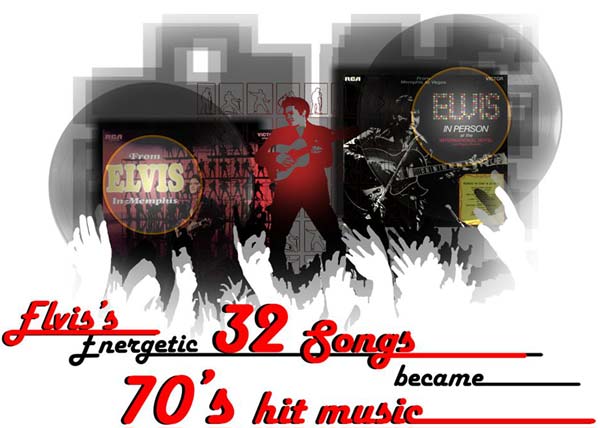
Just like in the past, Elvis again brought remarkable changes in his music sound and style in 1969, as he began recording in Memphis after almost 14 years. Elvis now preferred the American Sound studio where Chips Moman was the producer, over the clichéd RCA ambience. Backed by some of the best Memphis musicians and original lyrics, Elvis enthusiastically recorded many of his top musical works. 32 songs reflected the new ‘70s music environment that produced two hit albums, ‘From Elvis in Memphis’, ‘From Memphis to Vegas/From Vegas to Memphis’, and four classic singles. Every song reflected Elvis’ pulsating energy thatmarked the criterion for all his future songs. This resumed his mainstream recording career. Now, truly Elvis Presley’s music quality had reached new dimensions with new sounds in the albums that included modern country rhythm, some rock flavoured soul music and R&B music. Soon, Elvis also finally wound up his movie contracts with his 31st and last movie ‘Change of Habit’ that rose to No. 17 on the Variety’s Box Office Survey. But Elvis was yet to see the peak of his fame and glory as he would set the stage on fire with his dynamic live performances at Las Vegas.
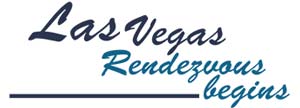
Las Vegas Rendezvous begins
Elvis Presley’s Las Vegas rendezvous began on the night of 31st July, 1969, at the brand new International Hotel. Elvis now received half a million dollars for his four-week concerts covering 57 shows. His musical entourage was massive, complete with his band of top grade back-up musicians. On his first night, memories of his past fiasco at the New Frontier Hotel, lingered on in his nervous mind. But Elvis delighted his euphoric audiences, including prominent celebrities to emerge victorious on his first live solo concert since 1961.
This show had fresh new songs and few classic hits presented in an original manner, along with Elvis’ appealing frolics. Elvis also did an encore singing ‘Can't Help Falling in Love’, his new closing number hereafter. Needless to say, all 57 shows received a fabulous reception. Elvis earned glowing reviews from the press and critics, while feeling extremely glad that he had fruitfully conquered his personal fears. Finally Elvis was back to live concerts. In fact, after the first performance night, the crafty Colonel Parker immediately renegotiated his famous client’s contract with the general manager of the International Hotel, who agreed to Elvis’ twice a year program over the next five years, for a fee of $1 million each year. Signed on a red tablecloth at the hotel, this was the legendary ‘red tablecloth deal’ Elvis was associated with. Indeed, these successful Las Vegas engagements during February and August each year commenced yet another exciting period in Elvis Presley’s live concert performance career.

Concert tours, Documentaries and Accolades
The Las Vegas shows where Elvis Presley repeatedly broke his own audience records, helped distance memories of Elvis as a singing hero in Hollywood movies, something that he always disapproved. In fact, from his second Las Vegas show in February 1970, Elvis consciously began obliterating his movie representation by launching his final revolutionary image and sound makeover, which stayed with him till his end. The layout of his unique, extravagant shows and music style would remain the same henceforth, though his bejewelled jumpsuits and dramatic stage acts would keep changing. Indeed, his overall colourful shows appealed to all and Elvis enjoyed enormous popularity. In a lighter vein, Elvis even joked with the crowd about his past image. Moreover, Elvis always met his loyal fans expectations with his natural display of his larger than life image, which romanticised him further in these live concerts of the early ‘70s.
With his live concert career back on track, by late February 1970, a second road touring phase commenced, lasting till his end. His opening venue was Houston’s gigantic Astrodome where his sophisticated concert show, his first ever since 1957 was witnessed by a record breaking audience. Though the vast crowd did intimidate Elvis, he gave six electrifying performances and was even mobbed by enthusiastic fans, just as in the past. MGM studios then began their work to document the living legend at the summit of his evergreen career, with two theatrically released documentaries that were incredibly successful. For their first documentary, ‘Elvis -That’s the Way It Is’ the crew candidly filmed Elvis on his August 1970 Las Vegas concert and then followed his road tour of nine cities in six days of September, a gruelling schedule that became a routine with Elvis. MGM’s second documentary titled ‘Elvis on Tour’ filmed after a year and half, gave a wonderful exposure of Elvis’ best and final career phase. It went on to win the Golden Globe Awards, in the category of Best Documentary film in 1972.
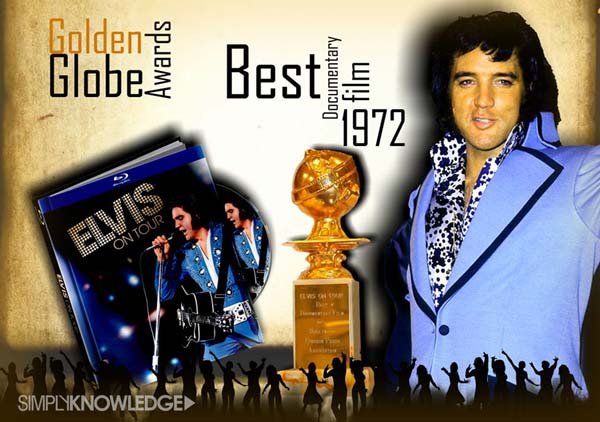
A week after Elvis Presley turned 36 he was honoured ‘One of the Ten Outstanding Young Men of the Nation’ by the United States Junior Chamber of Commerce (The Jaycees). It was a proud moment for Elvis, signifying that his accomplishments had been recognised. Elvis also received the Bing Crosby Award by the NARAS (National Academy of Recording Arts and Sciences), now known as the Grammy’s ‘Lifetime Achievement Award.’ Accolades and appreciations continued with his gospel album ‘He Touched Me’, winning him a second Grammy Award in the Best Inspirational Performance group in 1972.
While other engagements like the Sahara Lake Tahoe in Nevada continued, the highlights of his dynamic concert years are his Madison Square Garden concert in New York on June 1972, and in the following year, the most memorable show of his final period, ‘Aloha from Hawaii’. Colonel Parker had successfully organised this gigantically scaled benefit concert in Hawaii for the Kuiokalani Lee Cancer Fund. Technological advancements in global telecommunications had facilitated this innovative concert to be transmitted live via satellite to many countries all over the world. So Elvis’ live concert in front of a large audience on 14th January, 1973, was televised worldwide. After its repeated broadcast, it is estimated that more than a billion people saw it in 40 countries around the globe. Undeniably, 38-year old Elvis created television and entertainment history that night with his most spectacular show, where he raised almost $75000. This concert album remained on the Billboard’s album chart for 52 weeks at the No.1 slot.

The Fading Years
Till his Hawaii concert, Elvis was at the peak of his career and in top physical condition. In the same year, Elvis also performed in the maximum number of concerts, totalling 168. Before long, his debilitating road touring programs and live concert performances that continued without sufficient breaks began to show their detrimental effects on his health. It wasn’t long before Elvis felt fatigued and emotionally drained. Diagnosed with an early stage of glaucoma, it was the beginning of his physical and mental disorders like, high blood pressure, liver damage, enlarged colon, insomnia, depression, etc. Yet he continued his strenuous concert performances alongside his intermittent album recordings. Moreover, such demanding entertainment schedule and long periods of absence from home widened his marital discord with his wife Priscilla. The couple finally had an amicable divorce late in 1973. However, they maintained good relations and dutifully looked after their only daughter Lisa Marie Presley.
Soon, boredom caught up with Elvis on road tours and he increasingly grew professionally unchallenged. Elvis then lost his enthusiasm to bring about a novel change in his shows. Consequently his sold out tour performances, became predictably identical and repetitive. Besides, contrary to his friendly and gregarious public persona, Elviswho was already leading an unconventional lifestyle now became a recluse in his private life, totally disconnected from the outside world,except for his professional commitments. His over-obsessive fans had compelled him to live in isolation, in his inner sanctum at Graceland. Elvis also tried his best to come to terms with his marriage breakdown with Priscilla, and began dating Linda Thompson, a Memphis model. His mental and physical health deteriorated, especially after 1975 due to his harmful addiction to prescription drugs for various physicalailments and maladies. In reality, Elvis was abusing his body, claiming that he needed prescription drugs.
By now, Elvis Presley’s studio recording sessions at RCA too had declined. 40-year old Elvis directly entered the studio in March 1975 to record for the album ‘Today’. He skipped recording the previous year due to his many exhaustive live concert tours. Amongst them, one concert at Memphis won him the final Grammy Award for a gospel song ‘How Great Thou Art’ in the Best Inspiration Performance category. But soon thereafter, it became difficult for Elvis to give his concert performances. Age and a continuous diet of junk food too went against him as he put on a lot of weight, which he found difficult to shed. Elvis appeared bloated all over due to his poor health. He often missed concerts and even had to be hospitalised many a times. Now, his image in the media had widely taken a beating and changed to that of a tawdry pop-singer, while the critics felt that his music had precipitously decayed. Still, Elvis showed no signs of slowing down. Elvis had a huge back-up staff to support with his concerts, which combined with the prohibitive costs of maintaining Graceland, his generosity and his expensive lifestyle, also put an enormous strain on him. So Elvis continued for money. Linda Thompson moved on in 1976, seeing Elvis in his irreversible condition. Ginger Alden, another model soon occupied the space as Elvis Presley’s next girlfriend.
RCA then made alternate arrangements to record the unenthusiastic Elvis within the comforts of his home in Graceland, as he was reluctant to record at the studio. His recording sessions in February and October 1976 with producer Felton Jarvis, generated two mediocre albums, ‘From Elvis Presley Boulevard, Memphis, Tennessee’ and ‘Moody Blue’, his last album released in July 1977. After a series of concert performances, on 26th June, 1977, Elvis gave his concluding concert performance at Market Square Arena in Indianapolis.
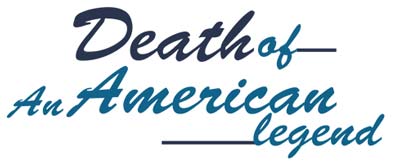
Death of An American legend
Elvis Presley’s end came on a hot summer day of 16th August, 1977, at Graceland. He had returned from the dentist late night and till the early morning hours, he was overlooking the preparation for his next scheduled tour to begin from Portland, Maine on the next day. After spending time with his family and daughter Lisa Marie, around 7.00 am, Elvis retired to rest before his evening flight. By afternoon Elvis was found dead by Ginger Alden in his bathroom. Elvis was holding the book, “The Scientific Search for the Face of Jesus.” After all attempts to revive him failed, it was announced to the whole world that Elvis Presley had died of an erratic heartbeat at the relatively young age of 42.
Elvis Presley was mourned by fans all over the world. Colonel Parker, who became responsible for Elvis’ rising career as an illustrious celebrity, was later criticised for pushing his client through such a severely taxing routine. But it was only years later that the official cause of Elvis Presley’s death was attributed to an overdose of prescription drugs that had caused a medical complication in his system. Legal actions were taken against his personal doctor George Nichopoulos, held responsible for prescribing pills in excess to Elvis. Later, he was exonerated of charges. Many controversies continued to erupt thereafter. But Elvis’ enormous worldwide fans continued keeping their legendary icon alive with conventions, memorabilia, fan clubs and other charitable activities. Many of them ritualistically continue till date in his memory. Gladys’ special boy today rests peacefully in Graceland, where his folklore continues to flourish and attract a new generation of music lovers.

The Legacy Continues
Elvis Aaron Presley, the multi-talented singer, actor and entertainer, had an extraordinary career filled with admiration as well as criticism. He received several awards posthumously and has also been inducted into all three ‘Halls of Fame’ – Country, Rock ‘n’ Roll and Gospel. But he will always be celebrated as the pioneer of ‘rock ‘n’ roll’ music, who left a huge impact with his unbelievable contributions to popular American cultures.
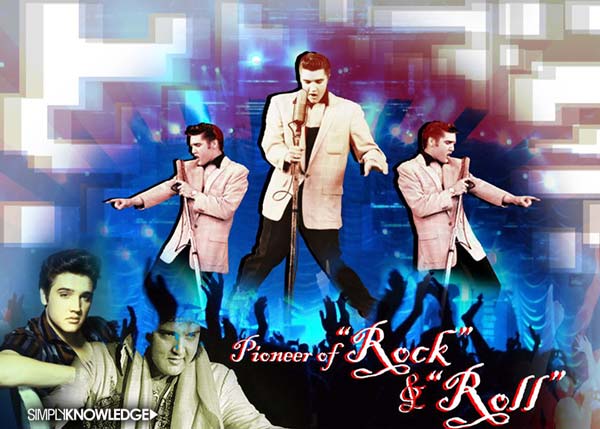
Apart from his music, Elvis loved his loyal fans for making him what he was, ‘Supernatural’, as the Rolling Stone magazine pronounced Elvis. His fans too loved him and considered him one amongst them, because in his journey from humble beginnings to a powerful position, Elvis always remained down to earth and accessible. This American folk legend lives on forever in the hearts of his fans as the legacy of his incredible music continues even today.
Classic records and albums continue to be sold, his better movies continue to be watched, and his TV specials too continue to be rebroadcast for the 21st century to rediscover him. Over a billion Elvis records have been sold worldwide that are breaking records even in this digital age. What's more, sound engineers, remixers and research teams at BMG group, who now own RCA, have been working hard to convert Elvis Presley’s songs from magnetic tapes into a digital format. They are remixing or remastering his music to present the name Elvis, his music and his image to today’s audience. So the ‘King’ of rock ‘n’ roll lives his dreams even today.
Next Biography








